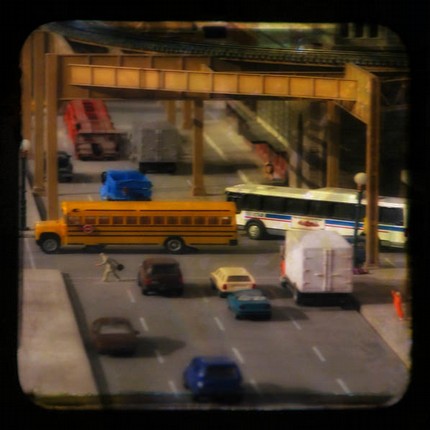Made in Chicago: James Spicer
By Jess D'Amico in Arts & Entertainment on Apr 11, 2008 4:55PM
 One of the best things about good art is that it transports you to another world, even if it's a realistic world, that you see through someone else's lens. That concept is especially true of the work of James Spicer. His photography focuses on urban life through miniature scenes (like Rush Hour right).
One of the best things about good art is that it transports you to another world, even if it's a realistic world, that you see through someone else's lens. That concept is especially true of the work of James Spicer. His photography focuses on urban life through miniature scenes (like Rush Hour right).
James, 36, was born across the street from Oz Park and thinks the best two places for hot dogs are Hot Doug's and SuperDawg. His prints and drawings can be purchased from his Etsy shop, or if you prefer, in book form. James has two photography books recently published, He is invisible in such a world and Here is the memory of what you are. Both deal with urban isolation through recreated city scenes.
Made in Chicago asked our questions and James told us stories about wine and cheese security guards, the coffee goddess, and his dream for nice weather in Chicago.
Chicagoist: How do you make your art stand out from everything else out there?
James: I do the type of art that I would like to own and admire, something worth hanging. Controversy, cleverness, and corniness are annoying, so I try to do art with a feeling that I would describe as loving sadness. But then to contradict myself I also put uplifting happiness into my work.
C: Where do you want to go with your art? Where do you see yourself in five years?
J: I want my art to go into cozy homes with furniture, plants, pets, people, music, and the smells of cooking. But all of that is out of my control. I just keeping doing it and putting it out there. Five years from now I hope to be pleasantly surprised as I accept the Nobel Peace Prize for inspiring humanity to calm down, the Queen of England will knight me Sir James Spicer, and Mayor Daley will give me the key to the city as I ride into town on a white donkey, handing out slices of pizza to the masses as flower petals and Skittles rain from the sky. After the collapse of the banking system prints of my art will be used as the new currency, transported on the backs of unicorns and satyrs. And the weather will be nice.
C: How did you start making stuff?
J: As far as photography, when I was three I started stealing my parents Polaroid camera and taking portraits of my stuffed animals and toys. With illustrations and writings I just doodled in stack after stack of notebooks. Everything I do is just a matter of playing around and having fun.
C: Why is the sky blue?
J: The sky is blue because humans have collectively decided that's how it ideally should be. When there is a sky it is always blue. Anything else is something else. At night there is no sky, only the stars and moon. During a storm there are clouds and lightening instead of a sky. Sunset is a sunset, and you say "look at the beautiful sunset." A blue sky can have white clouds in it, but a white sky is actually a huge white cloud in a blue sky.
C: What does your process look like?
J: I joyfully create thousands of works of art with ease. But then when it is time to do the work of organizing and releasing it I run and hide, look for any excuse to do something else, beg the coffee goddess to give me strength, and then use that strength to get angry about something someone did or said. Then I laugh at myself and try again tomorrow.
C: Tell us a secret. . .
J: My secret is that I keep juicy secrets that you would love to hear about. But I'll tell you a non-juicy one: I can't sleep unless I hug my balled up terrycloth bathrobe for a woobie blanket.
C: What's the Chicago art scene look like?
J: The formal art scene is desperate, pretentious, laughably overpriced, but impressive to old teachers that aren't ashamed to take some wine and cheese that's being guarded by someone from the gallery. It is the type of scene that I like to complain about when I drink too much coffee. The informal art scene is great I see some of the best art in small boutiques, restaurants, showings in home galleries, and on people's blogs.
C: Where do you see that scene going?
J: I think it is moving, and has already moved, from the academic world back into homes and neighborhoods, like folk art used to be, and old world craftsmanship. Online has really helped set artists free.
C: Any advice for beginners wanting to sell their stuff?
J: Let stuff sell itself. Never take advice from teachers that aren't successful artists. If you have a day job, quit without notice immediately and do or die. If you're selling online, don't put huge copyright notices all over your image. If you're selling in a gallery, don't be an evil-eyed security guard over the wine and cheese with a blow-hard story about what your art means. Make your creations with passion, like babies are made. Walk naked under the blue sky.
You wanna be featured in MiC? MadeinChicago[at]chicagoist[dot]com